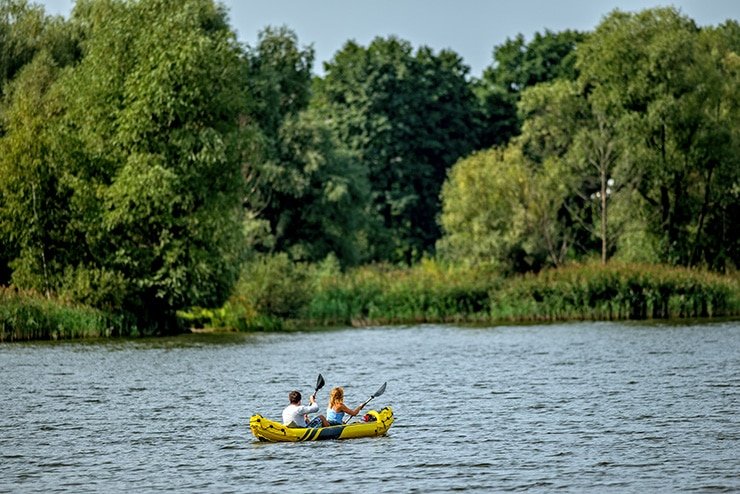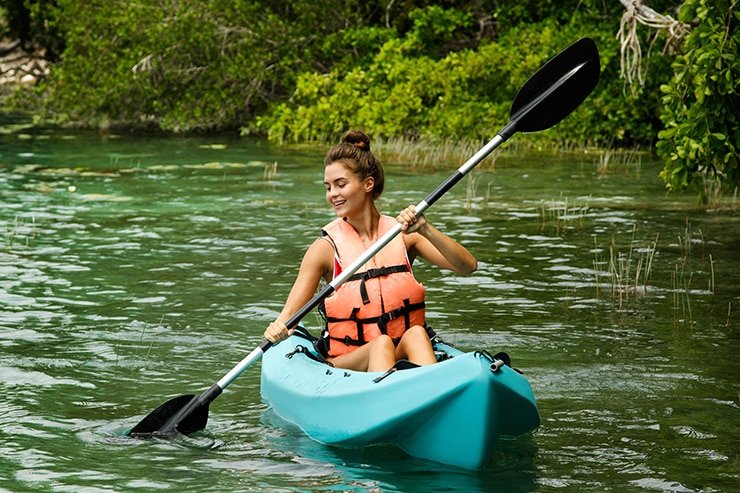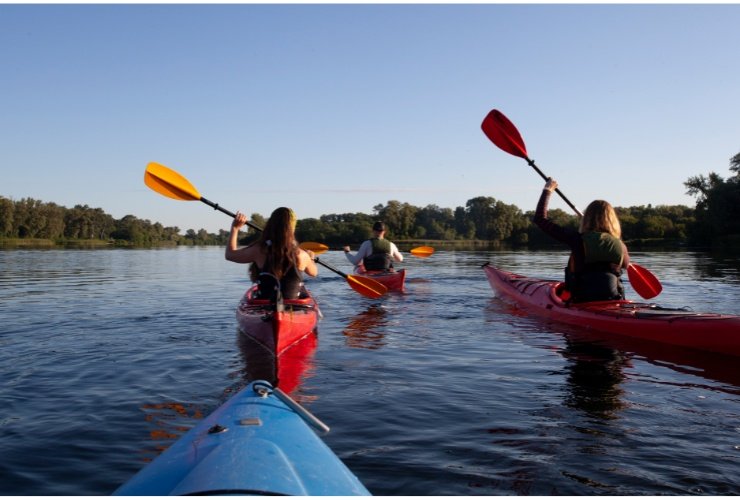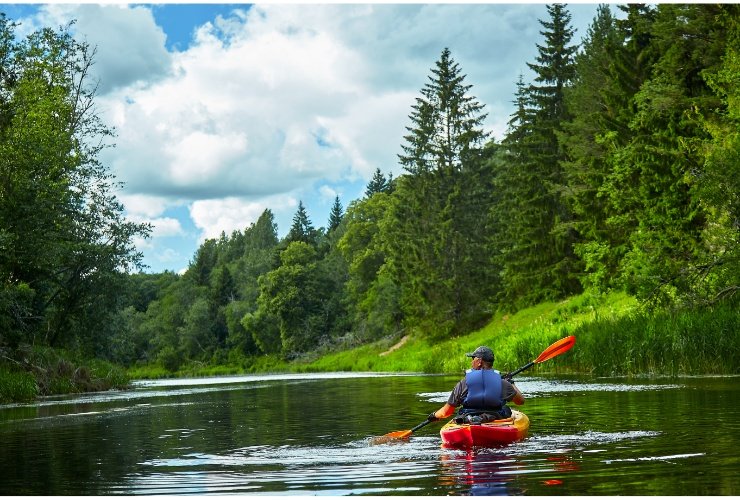Getting your head around the legal classifications of watercraft can be a bit confusing, and what applies to one state doesn’t always apply to another.
But is a kayak a personal watercraft? The answer depends on where you are drawing your definition of personal watercraft. In very broad terms, a kayak is a form of watercraft, but it doesn’t fall into the same definition as a personal watercraft (PWC) – as this refers to a small boat propelled by an inboard water jet engine (and can be an alternative term for a Jet Ski).
With this in mind, it’s understandable why there is some confusion around whether a kayak is classed as a personal watercraft or not. Let’s explore this question more thoroughly.
Key Takeaways
- Personal watercraft (PWC) is a small boat that uses an inboard jet drive to propel it through the water. It’s also referred to as a Jet Ski.
- Personal craft are any paddle craft and non-motorized vessels that are owned and operated by a single individual for recreational purposes, like a kayak.
- A kayak is a form of personal craft, but it is not a personal watercraft. It does not have an inboard jet drive or an internal combustion engine.
The US Coast Guard Classifies a Kayak as a Watercraft – Not a PWC
As a baseline, the US Coast Guard has a role in not just enforcing but also shaping maritime laws in the US. As such, any type of vessel on the water, even a typical recreational kayak can be classed as a watercraft.
So, in a nutshell, federal regulations state that any paddle craft and non-motorized vessels that are owned and operated by a single individual (not for commercial purposes) are considered personal craft.
But this is not the same as personal watercraft (PWC).
Personal watercraft are small boats that use an inboard jet drive to propel the craft through the water. So a kayak is not a PWC, despite being a form of watercraft. It’s confusing, isn’t it!
But What Is a Personal Watercraft?
There seem to be two schools of thought around what a personal watercraft is, and as such, this has led to conflicting information. A very literal way of defining personal watercraft appears to dominate a lot of the online literature, so you’ll likely see some blogs and message boards defining personal watercraft as a type of watercraft operated by an individual person.
By this definition anything you use as a means of transportation or recreation on a body of water can be classed as individual, recreational watercraft (this distinction is important because the maritime laws around commercial watercraft and personal watercraft will be different).
But this is not the same as a PWC.
A PWC can be an all-encompassing term, but, as already stated, it’s often used as an alternative term for a Jet Ski.
Is a Kayak a PWC?
So is a kayak a personal watercraft? There is a lot of confusion and misinformation out there, with conflicting definitions and confusing legislation. So, I tried to find a direct quote from the US coast guard that clearly outlines what a PWC is (at least in their eyes – which is all that matters).
And I did!
This definition comes directly from US Coast Guard training literature; Auxiliary Boat Crew Qualification Guide for PWC Operators:
“A Personal Watercraft (PWC) is a small vessel that is propelled by an internal combustion engine powering a jet pump or propeller. It is designed to carry from one to three persons, and operated by a person sitting, standing, or kneeling on the vessel rather than sitting or standing inside the vessel” – (US Coast Guard – PWC Operator Training Guide)
So, by this definition – a kayak is NOT a PWC.

Is a Kayak the Same as a Boat?
Technically speaking a kayak isn’t a boat in the sense of licensing purposes. However, depending on which state you’re located in this could change – inflatable kayaks with motors attached will most likely need to be registered in the same way as a boat, but this does depend.
However, a kayak (and a personal watercraft) isn’t the same as a boat, there are licensing and registration laws that separate them. It doesn’t matter if you have a sit-in kayak or not either, in a lot of cases any kayak that is typically propelled via a double-bladed paddle is not classed as a boat, and often doesn’t need to be registered or licensed (but this does vary from state to state).
Sea kayaks, whitewater kayaks, and recreational kayaks tend not to have a motor (in these cases, an outboard motor), either; so they’re not a PWC. It’s usually inflatable and fishing kayaks that have these motors.
ALSO READ: Is a Kayak Considered a Boat?
How Does a Personal Watercraft Classification Affect You?
Since a PWC classification is reserved for a small vessel that is propelled by an
internal combustion engine powering a jet pump or propeller, this means that kayaks do not fall into this category. So this means that there’s less licensing involved than with larger boats (if any).
There are different local laws and in some cases, a boating license may be necessary but this usually only applies if your kayak is over 16 feet in length and is powered by a motor.
The one thing that applies to most personal watercraft (by either definition) is safety equipment; all kayakers will be required to have a life jacket (and in some states a PWC operator will require a navigational light of some kind).

State Laws Regarding Personal Watercraft
There’s some conformity around US state laws and personal watercraft – so it’s advisable to check out regulations for your state – but remember, a PWC is not the same as a kayak!
Nearly every single state requires the use of a life jacket (referred to as a PFD or personal flotation device). The only two states that don’t require a PFD are Alaska and New Hampshire.
Some states limit the time that you can operate a personal watercraft but this is usually in times of reduced visibility such as the hours of darkness between sunset to sunrise (and most kayakers would tell you that’s not a good time to be out kayaking anyway).
Do I Need to Register a Kayak?
In most cases, you don’t need to register a kayak unless it’s over a certain length – touring kayaks can get quite long but the vast majority of kayaks will probably fall under a state’s maximum length.
To use Florida as an example, the regulations state that “any vessel with the exception of non-motor-powered vessels less than 16 feet in length, non-motor-powered canoes, kayaks, racing shells or rowing sculls, regardless of length, must be registered through your local Tax Collector’s Office.”
Whichever one of the states you’re in, the licensing rules should be available on the government website.
Be Aware of Restrictions Regarding Personal Watercraft and Kayaks
Several restrictions apply to personal watercraft that you should be aware of – not all of the PWC restrictions apply though. Unless your kayak has a motor installed you do not need to equip a fire extinguisher on it.
The following restrictions do apply:
- You must wear a Personal Flotation Device.
- You cannot kayak under the influence of alcohol or any substance that impairs your ability to operate the craft.
- Children can’t operate kayaks that have a motor attached.
- Whether or not you can kayak at night is determined by local state laws – in some cases, you’ll need to equip a navigation light, in others it is flat-out prohibited.
- You can be fined by authorities if you are operating your kayak “negligently” – this means you’re piloting your kayak in a way that puts you and others at unnecessary risk.
- You have to follow restricted area rules.

Navigational Rules for Personal Watercraft
Most of the navigational rules are fairly simple and shouldn’t be a major concern to most kayakers. The navigational rules are no-go areas and right-of-way rules that help keep kayakers and other boats safe – these are as follows:
- The larger boat always has the right of way – a kayaker can’t impede the passage of a large boat, this is to prevent blockages in narrower channels.
- No-go areas can include areas around a commercial port, military bases, nuclear power plants, anchored vessels, and refinery docks. These are all usually no-vessel zones and it’s unlikely that you’ll be anywhere near the vicinity of these.
Is a Sea Kayak Classed as a Personal Watercraft?
Just because a sea kayak is used on the ocean doesn’t mean it isn’t a personal watercraft. The same rules apply no matter the type of kayak you are paddling, whether it’s a fishing kayak, a white water kayak, an inflatable, or a tandem; if it is propelled by manpower, it isn’t a PWC. If it has a motor, you might be getting into a grey area (particularly if it’s a SOT kayak), so check your state regulations.
Conclusion
If we’re using the Coast Guard’s definition of a personal watercraft, then we have to say that no, a kayak is not a PWC. But there are still a fair few regulations to learn about PWCs that involve kayaks, and this information is there to help keep you safe on the water.
The most crucial thing is to look into your state’s local laws about licensing and operating times, check your local waterways to find out about regulations regarding the routes you plan on taking, and reach out to your local authority if you’re not sure.
Thank you for reading, and if you found the information here helpful then please like, comment, and share.

